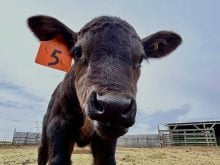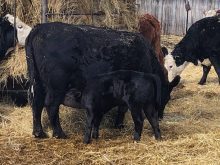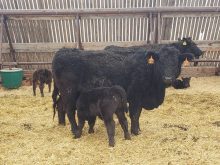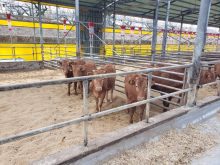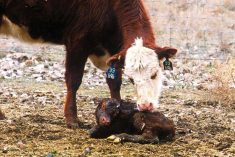Don’t let any recent balmy temperatures fool you. By the third week of the New Year, we should all have forgotten about climate change.
Late-gestating beef cattle, a few months away from calving, are going to need more dietary energy to maintain good body condition until calving and also to keep warm. Although, most people estimate the amount of cattle feed needed at the beginning of winter, a midwinter feed inventory review is a good idea to assure all cows receive adequate dietary energy and other nutrients preparing them for a successful calving season.
It becomes a matter of supplying enough dietary energy to your mature cows in order to maintain or achieve a body condition score (BCS) of 2.5-2.75 (thin = 1, and 5 = obese) by calving time, while replacement heifers should calve out a little better BCS of 3.
With a growing fetus (and placenta), their energy requirements are up about 25 per cent and protein needs increased by 10 to 15 per cent compared to the start of the winter. The nutrient requirements of the first-calf heifers are slightly more, because their bodies are still growing. They should be fed to gain 0.25-0.50 kg daily in addition to gained fetal weight gain. Thin mature cows can be fed, similarly.

Bump up the rations
Regardless of gestation stage, when midwinter outside temperatures drop in an arctic free-fall, the total energy requirements of every cow dramatically increase. University and extension environmental study on beef cattle has come up with a linear cold weather rule of thumb as follows: for every 1 C drop in temperature below 0 C, the beef cow’s TDN energy maintenance requirements are increased by about two per cent. If an early morning temperature is -25 C, there is an increase of about 50 per cent in the cows’ basic dietary energy needs.
Knowing cows will need more energy for late gestation (assuming April 1 calving date) and to get them through the coldest months of the winter (January and February), are good reasons to take an informative midwinter feed inventory.
Read Also

Harvest wraps up and fall work begins
At the Eppich famly ranch in western Saskatchewan, the fall harvest was successful with few breakdowns, cows and calves have been sorted and a new tractor has arrived
This means most beef cows with a decent BCS will require forage-based diets (supplemented with grain and protein feeds); of about 55 to 58 per cent TDN (total digestible nutrients) and about 12 per cent protein to maintain good body condition until calving. A mature gestating beef cow (500 to 600 kg) consumes about 2 to 2.25 per cent of her body weight (DMI basis) or about 10 to 13 kg of dry-based feed and wastes an additional amount of about 15 per cent. Knowing these requirements dozens of overwintering diets can be formulated and fed on a cow-calf operation.
Here is a breakdown feed inventory of a typical overwintering diet*, which takes into account these variables and could be fed in a 200-cow sample operation for a 90-day period until the first cow calves:
This practical example actually illustrates the feed inventory for 200 mature beef cows. However, producers can customize their own feed table based on the number of mature cows, number of first-calf heifers, number of replacement heifers and number of thin cows in the herd.
Along with what the cows consume and waste, there are also different degrees of storage waste that should be accounted. For example, there is about a five to 10 per cent storage waste for hay and straw bales stacked together and stored under a hay shed, while the same stacks housed outside and exposed to the elements might have 15 to 20 per cent storage loss. This means as illustrated above, if we need about 94 tonnes of grass hay to carry the cows for the late-gestation season, then we should have 100 to 110 tonnes of grass hay in total inventory.
After preparing a comprehensive midwinter inventory, we can anticipate potential feed shortages by the time of calving. For example, if our cow herd is caught short of forage, there are a few options for stretching the current inventory.
Whether our midwinter feed inventory shows us a shortage or ample feed supply for our late-gestation cows until calving, it is a good diagnostic tool. It helps us assure that cattle receive the proper amount of nutrition needed to prepare for calving and to survive a typical Canadian winter. Those cows that come through successfully will likely give birth to strong, healthy and profitable calves.





